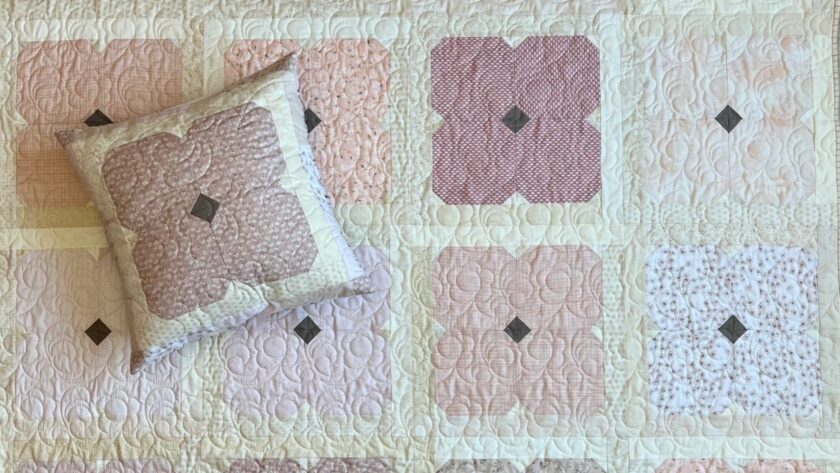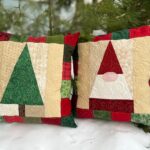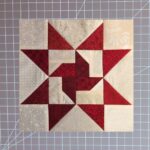Using snowball blocks to create the pretty blossoms, the Sweet Pea quilt pattern is so fun to make! This pattern includes directions for making an 18” x 18” quilted pillow cover, a 45” x 45” baby quilt, and a 60” x 60” throw quilt. Follow the charts below for fabric requirements and cutting directions for each of these options.
General Sewing Directions for Sweet Pea Quilt Pattern
The directions for this Sweet Pea Quilt pattern are for rotary cutting, machine piecing, machine quilting, and the binding is hand-stitched to the quilt back.
Accurate cutting and sewing enhances your final product. Pin your pieces together before sewing them to ensure proper seam alignment.
Use a ¼” seam allowance. I recommend using a special presser foot with a ¼” guide if you have one for your machine. This will help you get uniform seams, and matching corners!
Follow the directions described below as you press open the seams.
Post contains affiliate links and we earn commissions if you shop through the links on this page, including Amazon Associate links. For more information please read the disclaimer on the Privacy Policy page.
You can purchase an ad-free, printable PDF of the Sweet Pea quilt pattern in our Etsy shop!
Fabric Requirements for Sweet Pea Quilt Pattern
To achieve the scrappy look of this Sweet Pea Quilt I suggest using a variety of different pale pink and blush prints, and at least 8-10 different cream prints. Use different colors if you’d like, there are no rules!!! Either raid your stash, or purchase a few new fat quarters! Choose a coordinating fabric for the binding and for the backing.
| 18” x 18” Pillow | 45” x 45” Baby Quilt | 60” x 60” Throw Quilt | |
| Pink/Blush Fabric | ½ yard total | 1 yard total | 2 yards total |
| Cream Fabric for Background | ½ yard total | 1 ½ yards total | 2 yards total |
| Taupe Fabric | less than ⅛ yard | less than ⅛ yard | ⅛ yard |
| Binding Fabric | ¼ yard | ⅜ yard | ½ yard |
| Backing Fabric | ⅝ yard (quilt top backing) and ½ yard (envelop back) | 3 yards of 44” fabric or 1 ½” yards 108” fabric | 4 yards of 44” fabric or 2 yards of 108” fabric |
| Batting (thin cotton like Warm & Natural) | ⅝ yard of 90” batting or craft-size packaged batting | 1 ½ yards of 90” batting or twin-size packaged batting | 2 yards of 90” batting or twin-size packaged batting |
| Muslin for Pillow Form | ½ yard | — | — |
| Fiber Fill for Pillow Form | 1 pound | — | — |
Cutting Directions for Sweet Pea Quilt
Use a rotary cutter, plastic quilting ruler, and a self-healing cutting mat to cut the necessary pieces to make this pattern.
| 18” x 18” Pillow | 45” x 45” Baby Quilt | 72” x 72” Throw Quilt | |
| Pink/Blush Fabric | 4 – 6 ½” squares 12 – 2” x 5 ½” strips 4 – 2” x 2” squares | 36 – 6 ½” x 6 ½” squares | 64 – 6 ½” x 6 ½” squares |
| Cream Fabric for Background | 2 – 2” x 12 ½” strips 2 – 2” x 15 ½” strips 12 – 1 ½” x 1 ½” squares | 18 – 2” x 12 ½” strips 18 – 2” x 15 ½” strips 108 – 1 ½” x 1 ½” squares | 32 – 2” x 12 ½” strips 32 – 2” x 15 ½” strips 192 – 1 ½” x 1 ½” squares |
| Taupe Fabric | 4 – 1 ½” x 1 ½” squares | 36 – 1 ½” x 1 ½” squares | 64 – 1 ½” x 1 ½” squares |
| Binding Strips | — | 5 – 2 ½” x 44” strips or 9 – 2 ½” x 22” strips | 7 – 2 ½” x 44” strips or 14 – 2 ½” x 22” strips |
| Backing Fabric | 1 – 22” x 22” 2 – 12 ½” x 18 ½” units | 53” x 53” piece | 68” x 68” piece |
| Batting | 22” x 22” piece | 53” x 53” piece | 68” x 68” piece |
| Muslin for Pillow Form | 2 – 18 ½” x 18 ½” squares | — | — |
Making the Snowball Blocks
The flower blocks are made up of 4 snowball blocks surrounded by a border. Follow this chart to determine how many snowball blocks are needed for each project.
| 18” x 18” Pillow | 45” x 45” Baby Quilt | 72” x 72” Throw Quilt |
| 4 snowball blocks | 36 snowball blocks | 64 snowball blocks |
To make each snowball block you will use 1 – 6 ½” x 6 ½” colored square, 3 – 1 ½” x 1 ½” cream squares, and 1 – 1 ½” x 1 ½” taupe square.

Use a fine pencil and a straight edge and lightly draw a diagonal line on the back side of each of the 1 ½” squares.



Right sides together, pin these 1 ½” squares on each corner of the 6 ½” square with the diagonal lines perpendicular to the corner of the 6 ½” square. Sew together by stitching along the diagonal line, remove pins as you come up to them.
Trim the outside corners ¼” from the seam and press the seam open toward the pink middle.



You can view this video for making the Snowball Blocks!
Forming the Flower with the Snowball Blocks
Place 4 snowball blocks together with the taupe corners facing the middle to form the center of the flower.


Sew the top 2 snowball blocks together to form the top row.
Press seam to the right.
Sew the bottom 2 snowball blocks together to form the bottom row.
Press seam to the left.



Place the two rows right sides together and the middle seam where the taupe corners meet in the middle nested together. Pin in place.

Sew the two rows together to form the flower.

The flower will measure 12 ½” x 12 ½” square, trim if needed.

Sew a 2” x 12 ½” cream strip to opposite sides of the flower. Press seams toward the cream strips. Sew the 2” x 15 ½” cream strips to the remaining sides of the flower. Press seams toward the cream strips.


Trim, if needed, to make sure the unfinished block measures 15 ½” x 15 ½” square.
Assemble the Top of the Baby Quilt or Throw Quilt
Now that you have all your blocks ready, you want to plan how they’ll be arranged to make up the quilt top. I like to lay all my blocks on a design wall or the floor and play with arranging them until I get the look I want.

Each block is rotated in opposite directions to form the center design of where the sashing of the four blocks intersects.

Follow the diagrams shown here to obtain the design. The layout will be 3 blocks by 3 blocks (9 blocks) for the baby quilt and 4 blocks by 4 blocks (16 blocks) for the throw quilt.

Sew the blocks together (right sides facing) to complete each row. Remember to use a ¼” seam allowance.
Pressing the Rows of the Sweet Pea Quilt Pattern
I wait to press the rows until I have each of them sewn together. Be careful to just “press” and NOT “iron” the seams in a back-and-forth motion, or your quilt will stretch out of shape.
Begin by pressing the seams of the first row all in one direction. Press the seams of the second row in the opposite direction. Continue to rotate the pressing direction of each row until you have the seams of all rows pressed. Think…odd rows 1, 3, 5, etc. press the seams to the right. Even rows 2, 4, 6, etc. press the seams to the left.
By using this rotating direction of pressed seams, you will have nicely nested seams and less bulk when you sew the rows to each other. This method of pressing distributes the bulk, which will make you happy when machine quilting your project! Bulky seams can lead to bumpy quilting patterns, broken thread, and overall unevenness of your machine-quilted quilt top.
Sewing the Rows Together
Now that you have the pieced rows pressed, sew them together! Pin rows 1 and 2 together, right sides together. Make sure to line up and nest the seams, and pin to hold them in place. Remove the pins as you come to them when you’re stitching the ¼” seam. I like to press each set of rows as I sew them together.
The rows all get pressed in one direction, either towards the top of the quilt or towards the bottom. By pressing them all in one direction it will make for a uniform and smooth quilt top. Repeat until you have all of the rows sewn to each other and pressed.
Assemble the Pillow Top
Sew 1 – 15 ½” x 15 ½” flower block following the directions above.
On a table or design wall lay out the 2” x 5 ½” pink strips around the sides of the flower block. Place a 2” x 2” pink square in each corner.
Sewing along the 2” sides, sew together the pink strips on the left side to create a 2” x 15 ½” strip and the pink strips on the right side of the flower block to create another 2” x 15 ½” strip. Press seams to either the left or right, it doesn’t matter.
Sew these two strips to each side of the flower block where they belong. Press seams toward the cream fabric.
Again sewing along the 2” sides, sew the pink squares and strips across the top of the flower block to create a 2” x 18 ½” strip. Sew the pink squares and strips across the bottom of the block to create another 2” x 18 ½” strip. Press seams to either the left or right.

Sew these strips to the top and bottom of the flower block. Press seams toward the cream fabric. The unfinished pillow top should now measure 18 ½” x 18 ½” square.
Follow the directions below to quilt the pillow top to the 22” square piece of batting and the 22” square piece of quilt back fabric.
Layering the Top, Batting, and Back
I refer to layering the quilt as “sandwiching”. You need to sandwich the top and back with the batting in the middle.
Tape the Backing Down
On a hard surface floor, or with two large tables pushed together, use painter’s tape to tape down the backing fabric. As you tape the back down you’ll want to make sure the fabric is smooth, without wrinkles. Also, make sure the right side of the fabric is facing down!

Add the Batting
Lay the batting on top of the taped-down quilt back, and move your hands across it to smooth it all over. This will get rid of any wrinkles in the batting, and help to adhere it to the backing fabric.
Place the Quilt Top
Once you have the batting placed on top of the quilt back, center the quilt top over the two bottom layers. Right side facing up, of course! The two bottom layers of the quilt (the back and the batting) should extend about 4” all around the outside edges of the quilt top (2” for the pillow).
Move your hands across the quilt top to smooth it all over, and help remove any wrinkles. This will also help adhere the quilt top to the batting a little bit.
Baste the Layers
You can either spray baste your quilt layers or pin them together with 1 ½” stainless pins. Place pins around the entire quilt every 4-5 inches so the three layers don’t move around when you’re machine quilting this project.
Again, make sure all wrinkles are smoothed out. Adjust basting if needed to remove any wrinkles.
“Quilting” the Quilt
Use whatever free-motion stitch you’d like, or use a straight stitch to quilt in the ditches or along the seams. You’ll need a darning foot to free-motion quilt, and you’ll need to either be able to lower the feed dogs on the machine or place a special cover over them.

If you’re using a straight stitch to machine quilt you’ll need a walking foot.
Sewing the Pillow Form Insert for the Sweet Pea Quilt Pattern
Place the 2 – 18 ½” squares of muslin together, pin, and stitch around the edges ¼” removing pins as you come up to them. Leave a 5” opening on one side.

Trim the corners ⅛” and turn right side out.



Stuff with about 1 pound of Poly-fil. Turn the opening under and pin edges together.
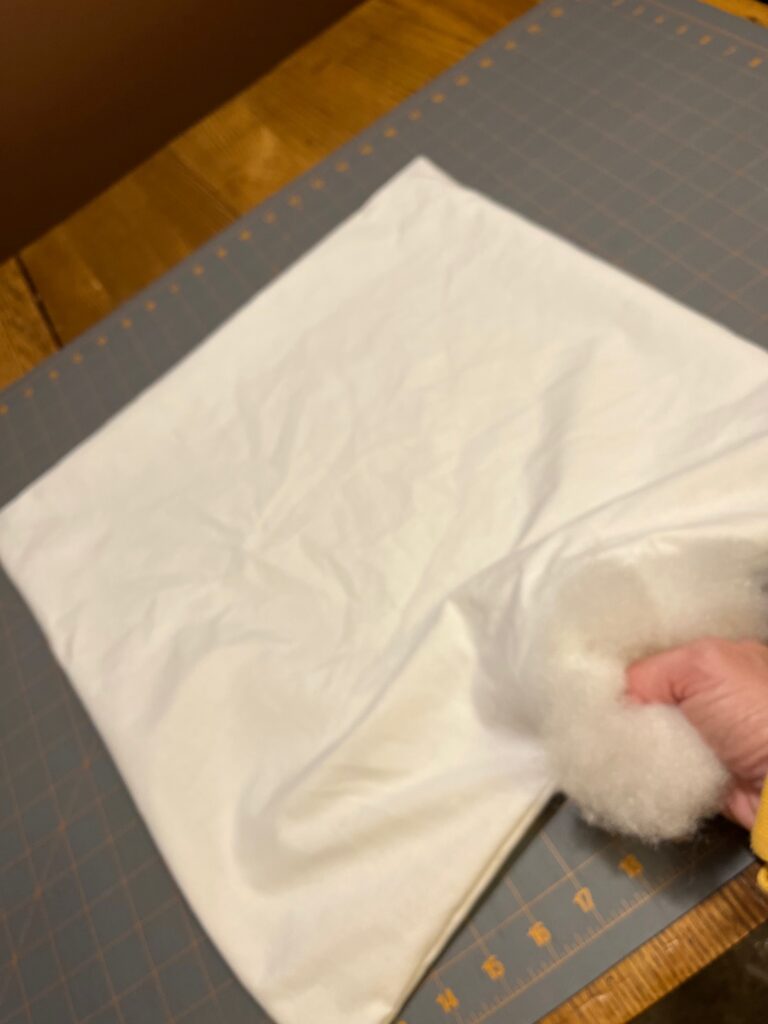

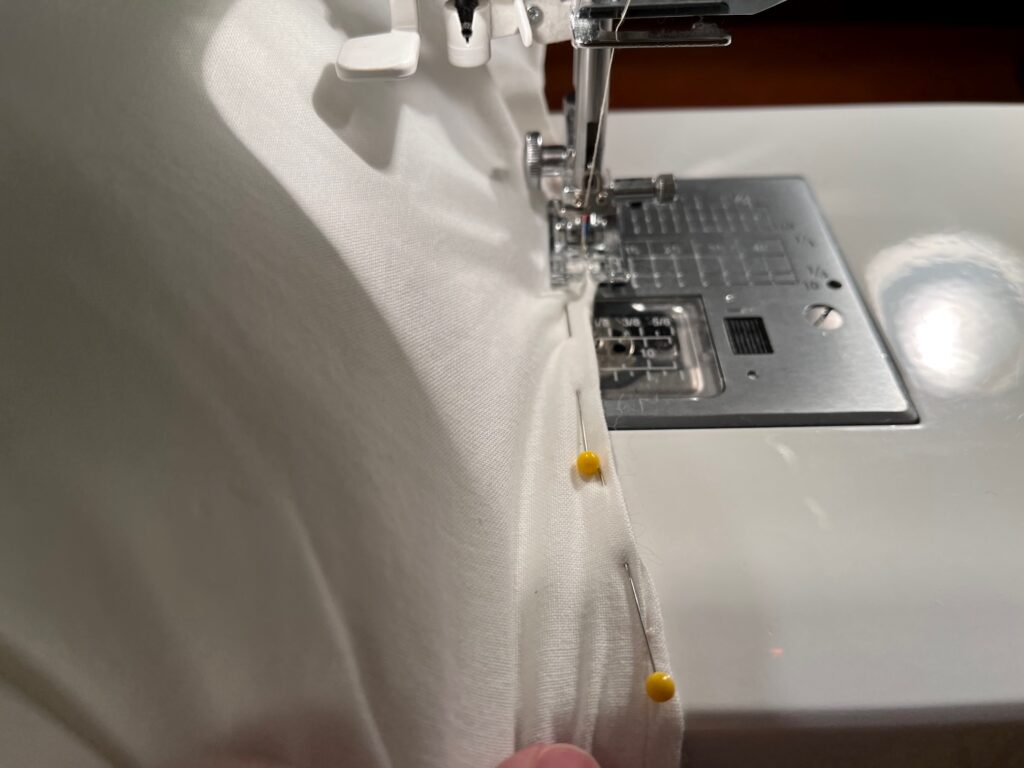
Sew the opening shut using about a ⅛” seam allowance, remove pins as you come to them.
Plump the pillow insert to remove lumps. Easy peasy!

View this video for making a pillow form insert!
Sewing the Quilted Pillow Cover
Once you’ve quilted the pillow top, sew the back pieces on to make it into an envelope pillow cover. For each of the 2 – 12 ½” x 18 ½” units, fold one right side of the 18 ½” side under ¼” and press. Fold under again ¼”, press, and stitch along the inside of the folded side to create a ¼” hem.
Place the “unhemmed” side of each of these two units along the opposite edges of the quilt top, right sides together with the right side of the quilt top, so that the hemmed edges of the backing units overlap each other in the center.

Pin in place all around each edge and stitch ¼” around all of the outside edges to sew the backing in place, removing pins as you sew up to them.

Trim corners about ⅛” and turn right side out. Carefully use the blunt end of a wooden skewer or the end of a small paintbrush to push the corners right side out. Stuff the quilted pillow cover with the 18” pillow form insert.


Binding the Sweet Pea Quilt Pattern
When you’ve finished quilting the layers together, it’s time to bind the edges of your Sweet Pea quilt pattern! You can use one color or several colors to make the binding!
Prepare the Binding
You can view this video on how to prepare binding for a quilt!
Fold each of the cut binding strips in half end to end. Use the 45° line on your plastic ruler to trim the ends at a 45° angle.
When you open the strips the angles on the ends will be facing in opposite directions.
Place the ends of two strips perpendicular, right sides together, and sew ¼” seam.
Repeat to join all strips into one long binding strip. Press seams open, then press long strip in half lengthwise, right side facing out.

Sew the Binding Strip to the Sweet Pea Quilt Pattern
Begin to sew the raw edge of the binding to the quilt by pinning it along one side. Be careful to sew the raw edge of the binding strip to the quilt, not the folded edge!
I usually start sewing the binding strip in the middle of the quilt side that I’m starting with. Start sewing about 8” in from the end of the binding strip, leaving a hanging “tail” on the binding. You’ll sew this to the other end of the binding strip when you finish sewing all along the sides of the quilt.
Stop sewing on the first side ¼” from the corner, use a pin to mark this location and sew right up to it. Backstitch a bit, and cut your thread but DON’T cut the binding strip.
Making the Mitered Corner
You can view this video for making a mitered corner!
Now, remove the quilt and binding strip from your machine and fold the binding strip straight up so it’s perpendicular from the side you were just sewing on.
Fold the binding strip back down on itself and match it to the edge of the quilt you just sewed it to, and the next edge of the quilt you’re about to sew it to. Pin this fold in place, and pin the binding strip to this edge of the quilt and continue to sew it, again stopping ¼” from the next corner and repeating the folding process described above. Continue in this manner until you are on the last side of the quilt, the side you started on.
Connecting the Ends of the Binding
Stop stitching about 14” – 16” from where you started. Backstitch and cut the thread (but not the binding strip, not yet!), remove the quilt and binding strip from the machine.

View this video on how to connect the tails of the quilt binding!
You now have two “tails” of the binding strip, tail #1 from where you started stitching it to the quilt and tail #2 from where you ended. You’ll need to join these tails together so that you have a continuous binding strip to finish sewing down to the quilt. Follow the steps below to join the tails!
STEP 1
Lay tail #1 of the binding strip along the unsewn edge of the quilt. Trim it at a 90° angle about half way between this unsewn edge.
STEP 2
Lay tail #2 of the binding strip over tail #1 along the unsewn edge of the quilt. Measure 2 ½” beyond the trimmed straight edge of tail #1. Mark this 2 ½” measurement with a pin or pencil, and trim the tail #2 at a 90° angle also. The two trimmed binding strip tails should overlap by 2 ½”.
STEP 3
Unfold the two tails so they lay flat. Pin the two tails together perpendicular to each other (right sides together). Use a fine pencil to draw a diagonal line from the corner of tail #2 to the opposite side, as shown here.
Sew along the drawn diagonal line. Fold binding strip in half again. The continuous binding strip should now lay flat along the unsewn edge of the quilt. If necessary, shorten or lengthen the continuous strip before trimming it. Then trim the outside corner ¼” from the seam and finger press the seam open. Fold it in half again and finish sewing the binding strip to the quilt.
Trim the Batting and Back
Trim the batting and quilt back to ¼” from the edge of the quilt top. I use a ruler and a rotary cutter to accomplish this task. Work carefully, so you don’t cut into your quilted project.

Hand-Stitch the Folded Binding Edge to the Quilt Back
You can view this video on how to prepare the hand-stitch the binding to the quilt back!
Here is my FAVORITE part of the process, hand-stitch the folded edge of the binding strip to the back of the quilt. When you get to the corner, carefully turn the corner right-side out to make a nice, mitered corner. I tack a few stitches up the corner to hold it in place, and then continue stitching along all sides and corners until…VOILA! Your binding is complete!
If you’d like, you can add a label to the back of your Sweet Pea Quilt. Enjoy!!
If you’re looking for more patterns, check out my easy Friendship Quilt pattern! This pattern comes in 3 sizes too!!!

